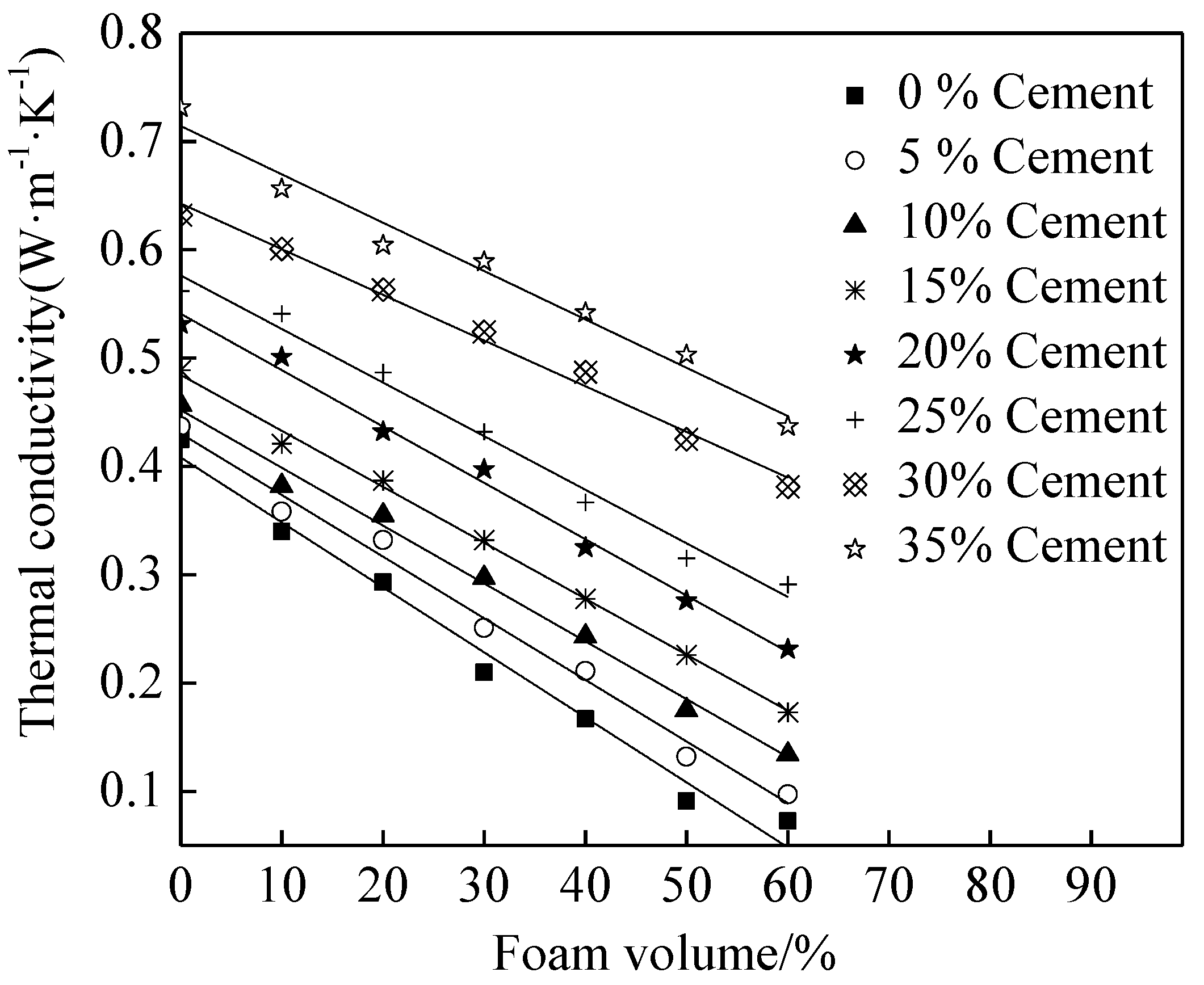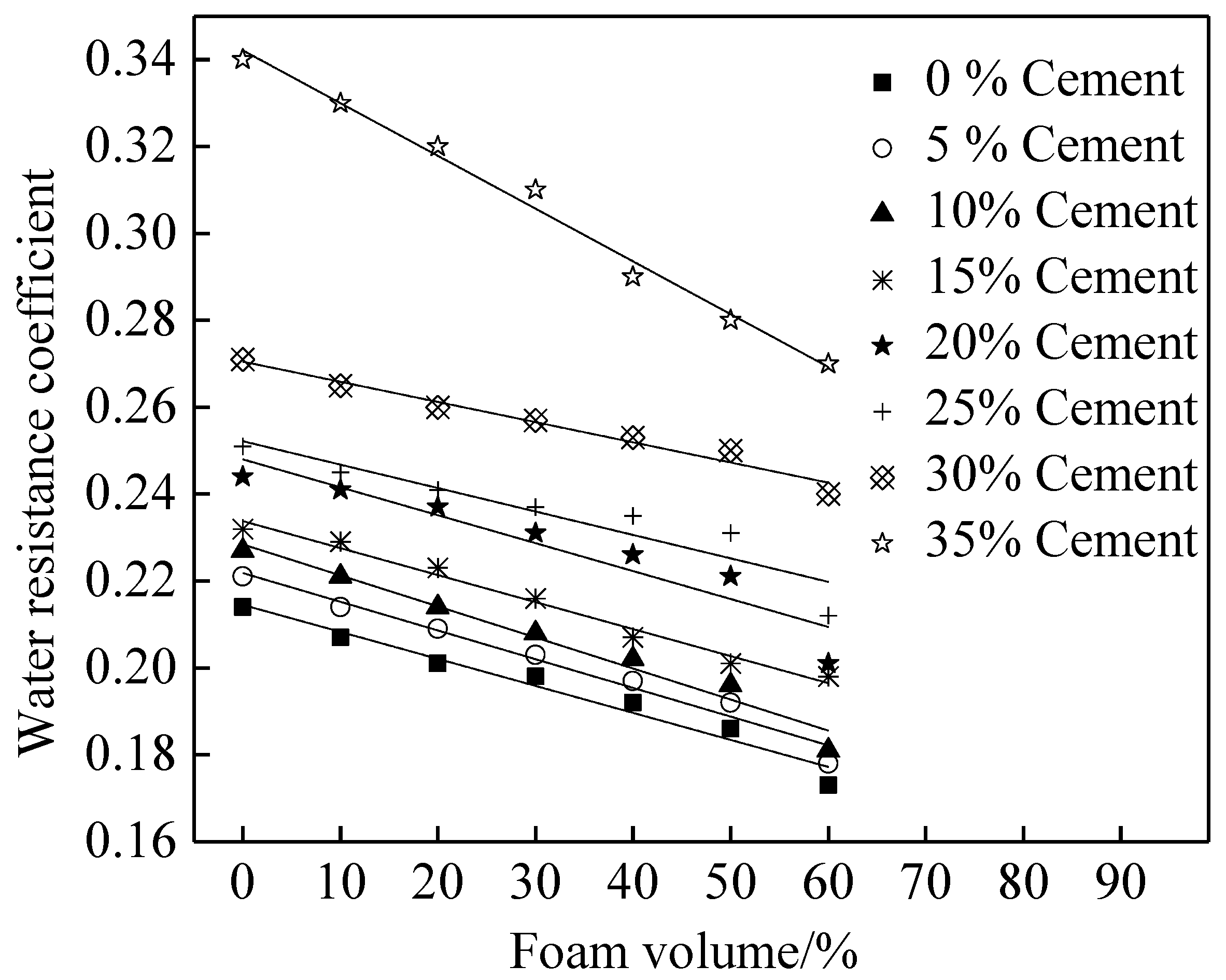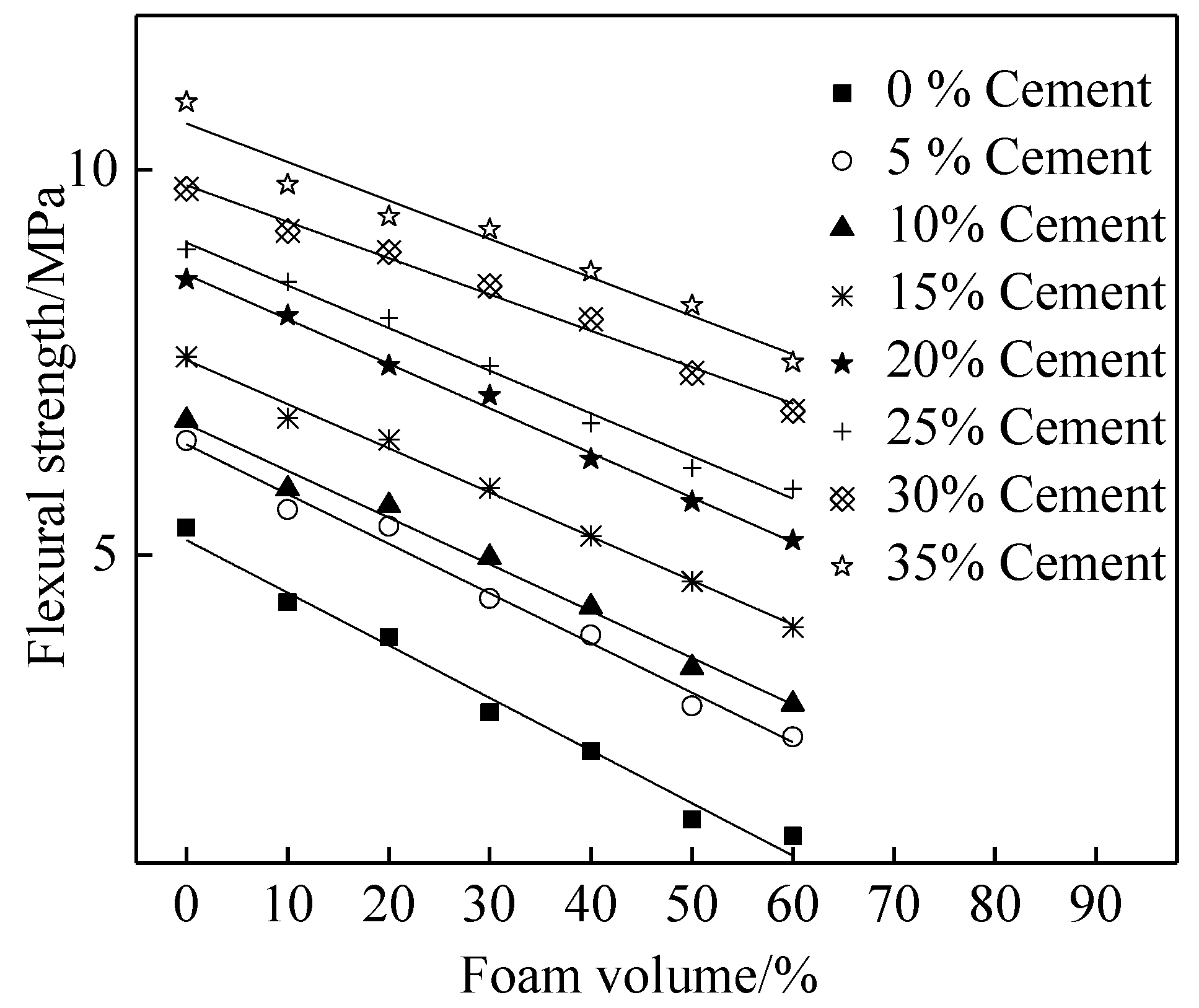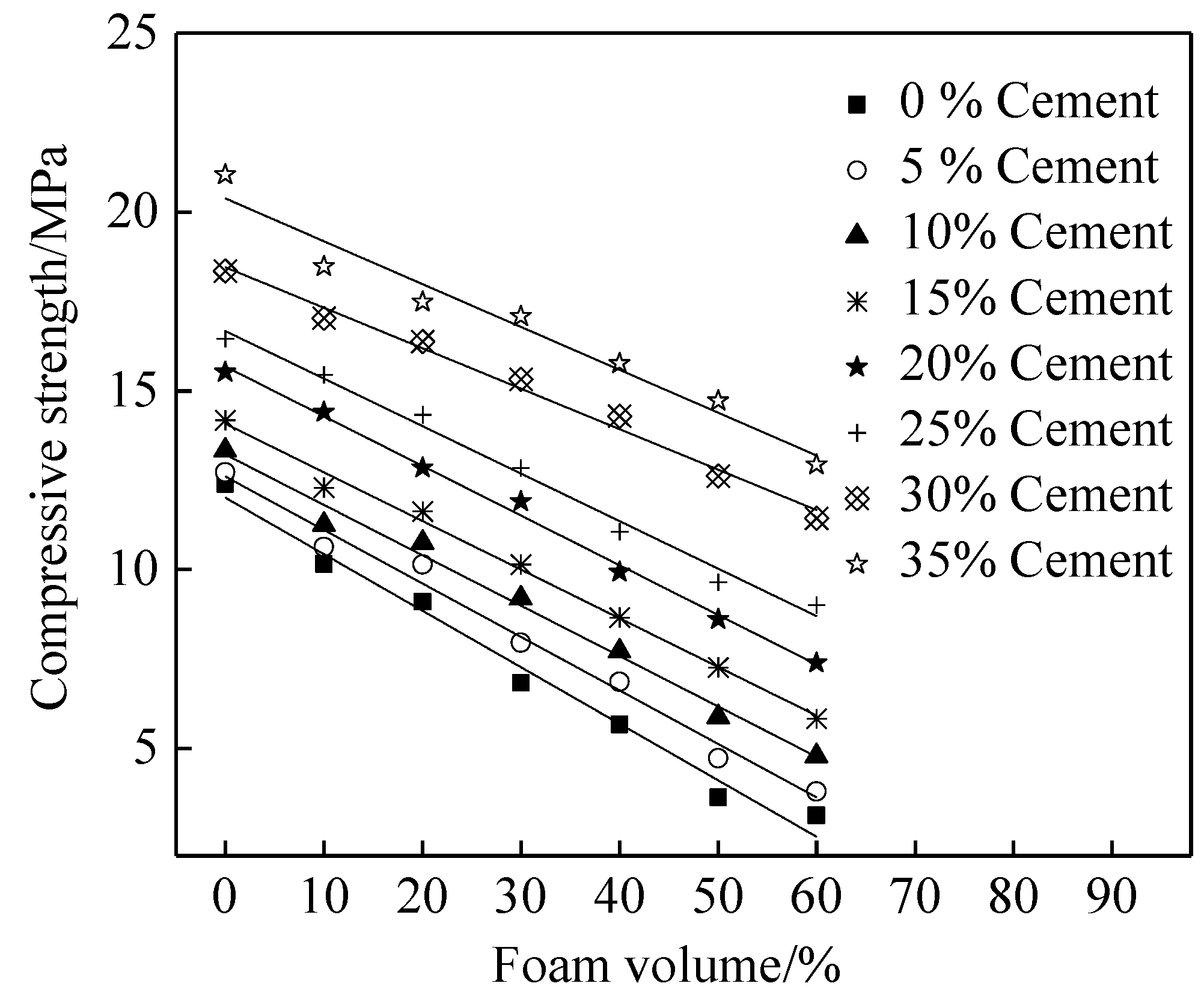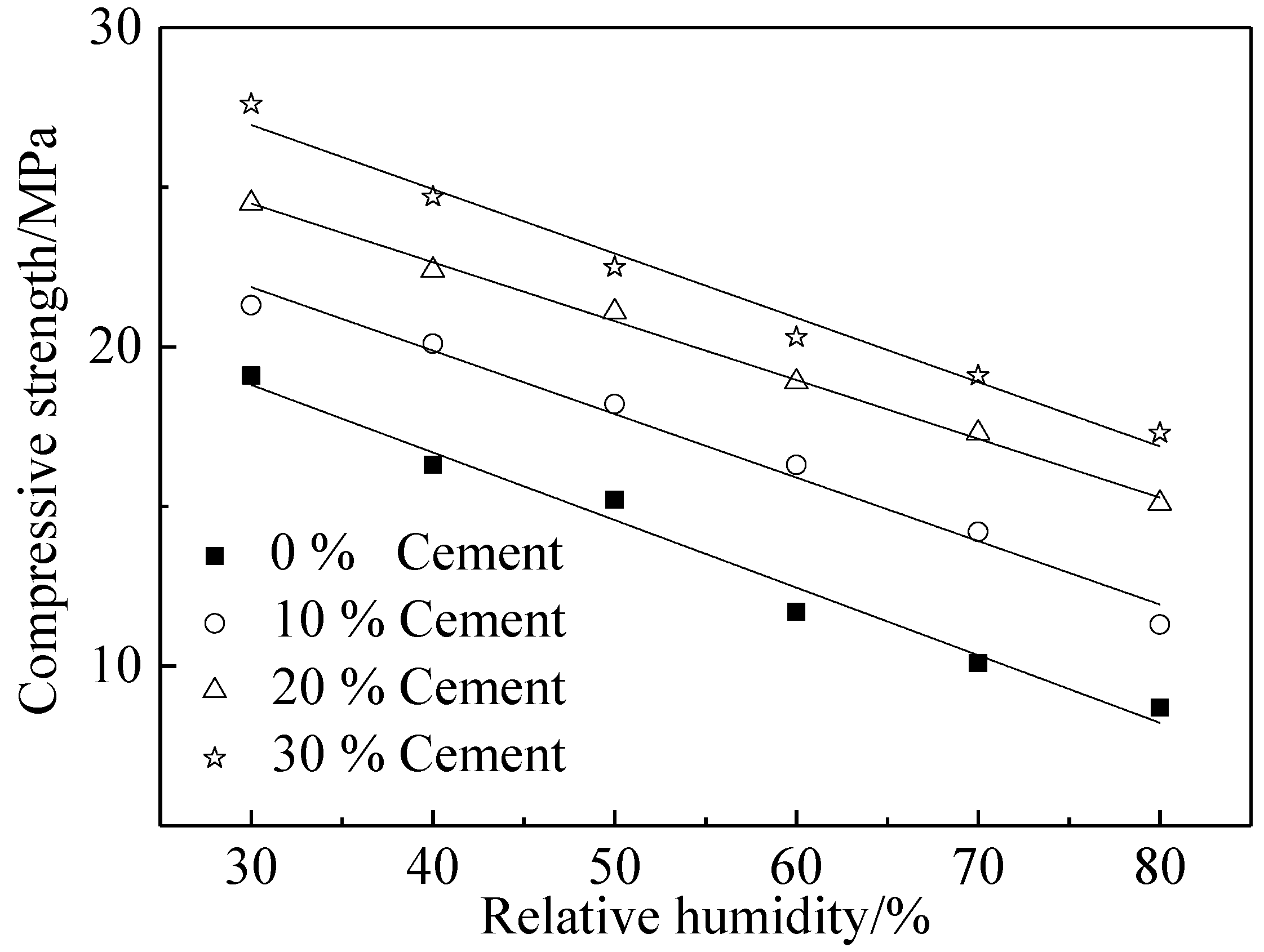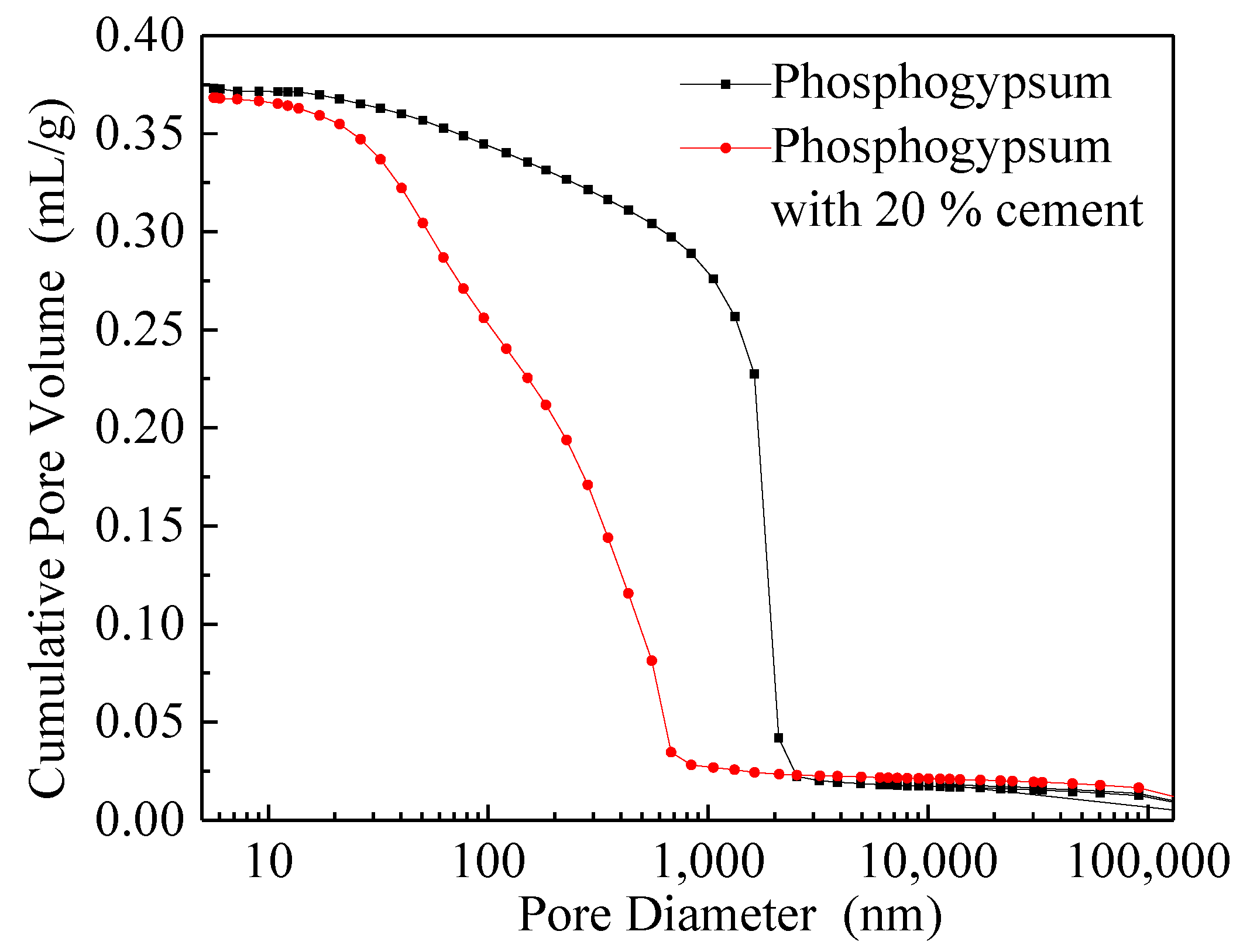1. Introduction
Phosphogypsum is a byproduct of wet process phosphoric acid. Each ton of phosphoric acid produced produces 5 tons of phosphogypsum. Generally, phosphogypsum is produced and stored as industrial waste in the yard. The main component of phosphogypsum is CaSO
4·2H
2O. If this kind of material is properly treated, then the phosphogypsum is a rich source of gypsum. However, impurities such as phosphorus, sulfate, fluoride, residual acid and heavy metals have affected the normal utilization of phosphogypsum. According to some statistical information, the utilization rate of global phosphogypsum is only about 15% [
1,
2,
3].
Nowadays, many studies on the reuse of phosphogypsum at home and abroad have been reported [
4,
5,
6]. The semihydrated gypsum can be used to prepare building gypsum and related products by using the cementitious properties [
7,
8]. Moreover, the phosphogypsum with sulfate activity under alkaline conditions can be used to manufacture the composite materials [
9,
10]. Li et al. [
11] studied the influence of fast burning on the mechanical properties and water resistance of phosphogypsum cementitious materials and found that the burning speed is beneficial to the mechanical strength of gypsum. Lin et al. [
12] has prepared the desulfurized gypsum fly ash composite cementitious material with strength higher than pure gypsum and water resistance coefficient higher than 0.85. Ma et al. [
13] pointed out that the soluble phosphorus and fluorine impurities in phosphogypsum can inhibit the diffusion and activity of SiO
2 and Al
2O
3. Moreover, the temperature and alkalinity can affect the activity of SiO
2 and Al
2O
3 [
14]. As obtained in Huang’s research that the compressive of composite material composed of 45% of phosphogypsum, 10% of steel slag, 35% of slag powder and 10% of limestone powder can reach 40 MPa [
15]. Zhou et al. [
16] found that the unburned bricks prepared by pressure molding of undisturbed phosphogypsum, river sand, cement and lime can reach the strength grade of MU25 according to GB11945-1999 Chinese standard.
Gypsum is porous with low mechanical strength, poor water resistance and good thermal insulation. The environmental humidity may result in vast turnarounds to the mechanical properties of gypsum. Although many studies on the mechanical performance and durability of gypsum products have been reported, little research is focused on the mechanical strength of phosphogypsum under different humidities [
17,
18,
19]. Additionally, phosphogypsum with foam can be applied for the preparation of thermal insulation wall materials.
In this paper, the thermal conductivity, water resistance coefficient and mechanical strengths (compressive and flexural strengths) of phosphogypsum mixed with foam and cement content ranging from 0% to 35% were studied. Moreover, the mechanical strengths were determined in various humidity environments. A scanning electron microscope was selected to observe the micromorphology of the phosphogypsum. Finally, the mercury intrusion porosimetry was used for the research of size distribution of pores in phosphogypsum.
2. Experimental
2.1. Raw Materials
The phosphogypsum used in this study is a kind of light-gray powder, which is produced by Guizhou Honghai Gypsum Powder Industry Co., Ltd., Guiyang, China. This phosphogypsum is mainly composed by CaSO
4·2H
2O. Moreover, some phosphorus oxide and fluoride exist in the phosphogypsum. Pungent odor gas is produced after the phosphogypsum is mixed with water. Ordinary Portland cement is used as another cementitious material.
Table 1 shows the main chemical compositions of phosphogypsum and ordinary cement. The plant foaming agent is Type JD-2 foaming agent containing 99% vegetable proteins produced by Zhengzhou Xinniu Chemical Products Co., Ltd., Zhengzhou, China, and is a light-yellow liquid. The gas production of this foaming agent is 10,000 mL/g. The decomposition temperature of the gas production is 80 °C. The high-range water-reducing agent with 40% water-reducing rate produced by Henan Lichuang lier Technology Co., Ltd. is used in this study.
Table 2 shows the particle size distribution of cementitious materials. The volume of foam in this study ranged from 0% to 60%. The water–binder ratio in this study is 1.0. The ratio of cement in this study ranged from 0% to 35% by mass of the total binder. The aggregates used in this study were river sand (fine aggregate) with fineness modulus of 2.35.
2.2. Samples Preparation and Measurement
The samples are prepared as follows:
The foaming agent is mixed and with water uniformly in a ratio of 1:30, and then the well-mixed foam solution is poured into a foaming machine to form foam. The phosphogypsum is mixed with water and stirred for 1 min to obtain a uniform fresh paste. Next, the fresh paste is mixed with the prepared foam to manufacture foamed phosphogypsum. The slump flow of the fresh paste is adjusted to 270 mm~280 mm by adding different dosage of water-reducing agent. The mixed foamed phosphogypsum is poured into the oiled mold to form specimens with size of 40 × 40 × 160 and 100 × 100 × 100. Three specimens are selected for this experiment, and the standard deviation is ±10%.
After being demolded, all specimens are treated in the 101-2A electrothermal blowing drying oven (with maximum drying temperature of 400 °C) manufactured by Tianjin Taisite Instrument Co., Ltd., Tianjin, China at temperature of 140 °C for 9 h. After drying, all specimens are cured in the room environment (40% relative humidity and the temperature of 20 °C) for 28 d.
TC3000E portable thermal conductivity tester was produced by Xi’an Xiaxi Electronic Technology Co., Ltd., Xi’an, China with the coefficient of thermal conductivity ranging from ~0.001–10 W/(m·K). Specimens with size of 100 × 100 × 100 are used for the measurement of thermal conductivity and water resistance coefficient. The mechanical strengths are measured according to the Chinese Standard GB/T 17671-1999. Some specimens with size of 100 × 100 × 100 are immersed in water until the weight is constant. The water resistance coefficient is the ratio of the compressive strength of specimen before immersed in water to the specimen under saturated condition. Automatic universal testing machine equipped with a relative humidity controllable box is provided to determine the mechanical strength of the specimens mixed with 10%, 20% and 30% cement and 30 % foam. The relative humidities in this study are 30%, 40%, 50%, 60%, 70% and 80%. All specimens are cured for 28 d in room environment and kept in this environment for 6 h before testing. The microstructure and crystal types of hydration products are determined by the JSM-6360LV scanning electron microscope (Japan Electron Optics Laboratory, Tokyo, Japan).
3. Results and Discussion
3.1. Thermal Conductivity
Figure 1 shows the thermal conductivity (
kx) of specimens with different cement content varying with the foam volume (
V).
Table 3 shows the fitting results of thermal conductivity and the foam volume. It can be observed from
Figure 1 that the thermal conductivity of specimens decreases linearly with the increasing foam volume. This is attributed to the fact that the foams in specimens can block the heat transmission, thus decreasing the thermal conductivity of specimens [
20,
21]. Moreover, the addition of cement leads to increasing the thermal conductivity of specimens. This can be ascribed to the fact that the structure of cement stone is more compact than that of phosphogypsum [
22,
23]. Finally, as obtained from
Figure 1 and
Table 3, the fitting degrees of these fitting functions are higher than 0.97, indicating that the thermal conductivity is a highly consistent linear function with the foam volume.
3.2. Water Resistance
Figure 2 shows the water resistance coefficient (
K) of specimens with different cement content varying with the foam volume (
V). As shown in
Figure 2, the water resistance coefficient decreases with linear function. It can be observed from
Figure 2 that the foam volume demonstrates negative effects on the water resistance of phosphogypsum. This is attributed to the fact that the increased diameter and number of pores induced by the increased foam volume make more water enter the phosphogypsum, thus leading to the destruction of its structures and the decline in its mechanical strength [
24,
25]. However, the addition of cement results in increasing the water resistance coefficient of specimens due to the improved compactness of the phosphogypsum, thus preventing the immersion of water and improving the water resistance coefficient of phosphogypsum [
26,
27]. Moreover, as obtained from
Figure 2 and
Table 4, the fitting degree of the fitting function is higher than 0.846; therefore, the relationship between water resistance coefficient and foam volume fits well with a linear function.
3.3. Mechanical Strengths
Figure 3 and
Figure 4 show the mechanical strengths (flexural and compressive strengths) of phosphogypsum varying with different foam volume. It can be observed from
Figure 3 and
Figure 4 that the mechanical strengths decrease linearly with the increasing foam volume. This is attributed to the fact that the increased foam volume can lead to increasing the internal porosity of phosphogypsum, thus decreasing the mechanical strengths [
28,
29]. However, the addition of cement can improve the compactness of the microstructures of phosphogypsum, thus improving the mechanical strengths [
30,
31].
Table 5 and
Table 6 show the fitting results of flexural and compressive strengths of phosphogypsum and the foam volume, respectively. As expressed in
Table 4 and
Table 5, the fitting degrees of all fitting curves are higher than 0.95; therefore, the mechanical strengths and the foam volume fit well with linear function.
Figure 5 and
Figure 6 show the mechanical strengths (flexural and compressive strengths) varying with the relative humidity. It can be observed from
Figure 5 and
Figure 6 that the mechanical strengths decrease linearly with the increasing relative humidity. This is attributed to the fact that the phosphogypsum is in contact with water more frequently when the relative humidity increases, leading eventually to the destruction of the phosphogypsum’s structure [
32,
33]. Consequently, the phosphogypsum is corroded by water seriously by water. Therefore, the mechanical strengths decrease with the increasing relative humidity. However, as illustrated in
Figure 5 and
Figure 6, the addition of cement demonstrates a positive effect on the mechanical strengths of phosphogypsum, due to the fact that the cement is able to improve the compactness of microstructure of the phosphogypsum [
34,
35]. Thus, the addition of cement leads to the improvement of mechanical strengths of the phosphogypsum. Finally, as obtained from
Figure 5,
Figure 6 and
Table 7 and
Table 8, the fitting degree of the fitting function is higher than 0.97; therefore, the relationship between relative humidity and mechanical strengths fits well with linear function. Compared with the compressive strengths of phosphogypsum-based cemented backfill and the hemihydrate phosphogypsum-based foam insulation materials, phosphogypsum mixed with cement shows better compressive strength [
36,
37].
3.4. Microscopic Analysis
Figure 7 shows the scanning electron microscope (SEM) photos of phosphogypsum. As shown in
Figure 7a, the phosphogypsum with no cement shows a large number of tiny needle-like hydration products and columnar lamellar around phosphogypsum.
Figure 7b shows the scanning electron microscope (SEM) photos of phosphogypsum with 20% cement by mass to the total binder. It can be seen in
Figure 7b that more sheet integral hydration products can be found in
Figure 7. This is attributed to the fact that the cement can react with water, forming hydraulic hydration products. Therefore, as obtained from
Figure 7, the addition of cement is able to improve the compactness of the hydration products, thus increasing the mechanical strengths of phosphogypsum.
Figure 8 shows the curves of the relationship between the pore diameter and the cumulative pore volume of phosphogypsum or phosphogypsum with 20% cement. As illustrated in
Figure 8, the main pore diameter of phosphogypsum varies from 5.65 nm to 3.45 × 10
5 nm. Meanwhile, the main pore diameter of phosphogypsum with 20% cement varies from 5.65 nm to 9.07 × 10
4 nm. Therefore, the phosphogypsum shows larger pore diameter and cumulative pore volume than the phosphogypsum with 20% cement. Due to smaller pore diameter and cumulative pore volume, the phosphogypsum with 20% cement presents better water resistance and mechanical strengths.
4. Conclusions
Based on this research, the conclusions can be summarized as follows:
(1) The relationships between these parameters (thermal conductivity, water resistance coefficient and the mechanical strengths) and foam volume of phosphogypsum can be described as a linear function well. The addition of cement demonstrates positive correlation to the thermal conductivity, the water resistance coefficient and the mechanical strengths.
(2) The mechanical strengths (flexural and compressive strengths) decrease linearly with the relative humidity of testing environment. The consistency of linear relationship is high. The addition of cement demonstrates a positive effect on the mechanical strengths of phosphogypsum.
(3) The addition of cement is able to improve the water resistance of phosphogypsum. Moreover, the compactness of phosphogypsum is increased, and the diameter and volume of pores in phosphogypsum are decreased by adding the cement.
Author Contributions
Conceptualization, L.F. and K.J.; methodology, H.W.; software, K.J.; validation, L.F., K.J. and H.W.; formal analysis, H.W.; investigation, H.W.; resources, H.W.; data curation, K.J.; writing—original draft preparation, L.F.; writing—review and editing, L.F.; visualization, L.F.; supervision, L.F.; project administration, H.W.; funding acquisition, H.W. All authors have read and agreed to the published version of the manuscript.
Funding
This research was funded by National Natural Science Foundation of China [No. 51878360].
Institutional Review Board Statement
Not applicable.
Informed Consent Statement
Not applicable.
Data Availability Statement
The data used to support the findings of this study are available from the corresponding author upon request.
Conflicts of Interest
The authors declare that there are no conflict of interest regarding the publication of this paper.
References
- Aminul Haque, M.; Chen, B.; Liu, Y.; Farasat Ali Shah, S.; Ahmad, M. Improvement of physico-mechanical and microstructural properties of magnesium phosphate cement composites comprising with Phosphogypsum. J. Clean. Prod. 2020, 261, 5–10. [Google Scholar] [CrossRef]
- Mei, F.; Hou, J.; Liu, Z. Research on Activity Characteristics on Composite Cementitious Materials Based on Phosphogypsum. Procedia Eng. 2012, 43, 9–15. [Google Scholar]
- Zhou, J.; Gao, H.; Shu, Z.; Wang, Y.; Yan, C. Utilization of waste phosphogypsum to prepare non-fired bricks by a novel Hydration-Recrystallization process. Constr. Build. Mater. 2012, 34, 114–119. [Google Scholar] [CrossRef]
- Zhou, J.; Yu, D.; Shu, Z.; Li, T.; Chen, Y.; Wang, Y. A novel Two-step Hydration Process of preparing cement-free non-fired bricks from waste phosphogypsum. Constr. Build. Mater. 2014, 73, 222–228. [Google Scholar] [CrossRef]
- Fabiani, C.; Pisello, A.L.; D’Alessandro, A.; Ubertini, F.; Cabeza, L.F.; Cotana, F. Effect of PCM on the Hydration Process of Cement-Based Mixtures: A Novel Thermo- Mechanical Investigation. Materials 2018, 11, 871. [Google Scholar] [CrossRef] [Green Version]
- Zhang, Y.; Pan, F.; Wu, R. Study on the performance of FGD gypsum-metakaolin-cement composite cementitious system. Constr. Build. Mater. 2016, 128, 1–11. [Google Scholar] [CrossRef]
- Pinto, S.; Angulski da Luz, C.; Munhoz, G.; Medeiros-Junior, R. Durability of phosphogypsum-based supersulfated cement mortar against external attack by sodium and magnesium sulfate. Cem. Concr. Res. 2020, 136, 106172. [Google Scholar] [CrossRef]
- Liu, S.; Wang, L.; Yu, B. Effect of modified phosphogypsum on the hydration properties of the phosphogypsum-based supersulfated cement. Constr. Build. Mater. 2019, 214, 9–16. [Google Scholar] [CrossRef]
- Liu, S.; Ouyang, J.; Ren, J. Mechanism of calcination modification of phosphogypsum and its effect on the hydration properties of phosphogypsumbased supersulfated cement. Constr. Build. Mater. 2020, 243, 118226. [Google Scholar] [CrossRef]
- Liang, H.; Li, J. The influence of hydration and swelling properties of gypsum on the preparation of lightweight brick using water supply reservoir sediment. Constr. Build. Mater. 2015, 94, 691–700. [Google Scholar] [CrossRef]
- Li, F.L.; Qian, J.S.; Ni, X.Q.; Zhang, C.; Lin, Z. Effect of fast firing on composition and cementations’ properties of phosphogypsum dehydration phase. J. Chin. Ceram. Soc. 2015, 5, 579–584. [Google Scholar]
- Lin, F.; Peng, J.; Cong, G.; Lei, W. Hydration hardening mechanism and water resistance of desulfurized gypsum fly ash cement. J. Chin. Ceram. Soc. 1995, 2, 219–223. [Google Scholar]
- Ma, L.; Ning, P.; Zheng, S.; Niu, X.; Zhang, W.; Du, Y. Reaction mechanism and kinetic analysis of the decomposition of phosphogypsum via a solid-state reaction. Ind. Eng. Chem. Res. 2010, 49, 3597–3602. [Google Scholar] [CrossRef]
- Chen, X.; Gao, J.; Zhao, Y. Investigation on the hydration of hemihydrate phosphogypsum after post treatment. Constr. Build. Mater. 2019, 229, 116864. [Google Scholar] [CrossRef]
- Huang, Y.; Lin, Z. Investigation on phosphogypsum-steel slag-granulated blast-furnace slag-limestone cement. Constr. Build. Mater. 2010, 24, 1296–1301. [Google Scholar] [CrossRef]
- Zhang, L.; Zhang, A.; Li, K.; Wang, Q.; Han, Y.; Yao, B.; Gao, X.; Feng, L. Research on the pretreatment and mechanical performance of undisturbed phosphogypsum. Case Stud. Constr. Mater. 2020, 13, e00400. [Google Scholar] [CrossRef]
- Rashad, A. Phosphogypsum as a construction material. J. Clean. Prod. 2017, 166, 732–743. [Google Scholar] [CrossRef]
- Gu, K.; Chen, B. Research on the incorporation of untreated flue gas desulfurization gypsum into magnesium oxysulfate cement. J. Clean. Prod. 2020, 271, 122497. [Google Scholar] [CrossRef]
- Lanzon, M.; Garciaruiz, P. Effect of citric acid on setting inhibition and mechanical properties of gypsum building plasters. Constr. Build. Mater. 2012, 28, 506–511. [Google Scholar] [CrossRef]
- Altun, I.; Sert, Y. Utilization of weathered phosphogypsum as set retarder in Portland cement. Cem. Concr. Res. 2004, 34, 677–680. [Google Scholar] [CrossRef]
- Kumar, S. Fly ash-lime-phosphogypsum hollow blocks for walls and partitions. Build. Environ. 2003, 38, 291–295. [Google Scholar] [CrossRef]
- Shen, W.; Zhou, M.; Zhao, Q. Study on lime-fly ash-phosphogypsum binder. Constr. Build. Mater. 2007, 21, 1480–1485. [Google Scholar] [CrossRef]
- Nizevičienė, D.; Vaičiukynienė, D.; Vaitkevičius, V.; Rudžionis, Ž. Effects of waste fluid catalytic cracking on the properties of semi-hydrate phosphogypsum. J. Clean. Prod. 2016, 137, 150–156. [Google Scholar] [CrossRef]
- Amrani, M.; Taha, Y.; Kchikach, A.; Benzaazoua, M.; Hakkou, R. Phosphogypsum recycling: New horizons for a more sustainable road material application. J. Build. Eng. 2020, 30, 101267. [Google Scholar] [CrossRef]
- Cánovas, C.; Chapron, S.; Arrachart, G.; Pellet-Rostaing, S. Leaching of rare earth elements (REEs) and impurities from phosphogypsum: A preliminary insight for further recovery of critical raw materials. J. Clean. Prod. 2019, 219, 225–235. [Google Scholar] [CrossRef]
- Xu, J.; Fan, L.; Xie, Y.; Wu, G. Recycling-equilibrium strategy for phosphogypsum pollution control in phosphate fertilizer plants. J. Clean. Prod. 2019, 215, 175–197. [Google Scholar] [CrossRef]
- Contreras, M.; Pérez-López, R.; Gázquez, M.; Morales-Flórez, V.; Santos, A.; Esquivias, L.; Bolívar, J. Fractionation and fluxes of metals and radionuclides during the recycling process of phosphogypsum wastes applied to mineral CO2 sequestration. Waste Manag. 2015, 45, 412–419. [Google Scholar] [CrossRef] [PubMed] [Green Version]
- Canut, M.; Jacomino, V.; Bråtveit, K.; Gomes, A.; Yoshida, M. Microstructural analyses of phosphogypsum generated by Brazilian fertilizer industries. Mater. Charact. 2008, 59, 365–373. [Google Scholar] [CrossRef]
- Narloch, D.; Paschuk, S.; Corrêa, J.; Rocha, Z.; Mazer, W.; Torres, C.; Del Claro, F.; Denyak, V.; Schelin, H. Characterization of radionuclides present in portland cement, gypsum and phosphogypsum mortars. Radiat. Phys. Chem. 2019, 155, 315–318. [Google Scholar] [CrossRef]
- López, F.; Tayibi, H.; García-Díaz, I.; Alguacil, F. Thermal dehydration kinetics of phosphogypsum. Mater. Constr. 2015, 65, 1–16. [Google Scholar] [CrossRef] [Green Version]
- Singh, M. Treating waste phosphogypsum for cement and plaster manufacture. Cem. Concr. Res. 2002, 32, 1033–1038. [Google Scholar] [CrossRef]
- Shen, W.; Gan, G.; Dong, R.; Chen, H.; Tan, Y.; Zhou, M. Utilization of solidified phosphogypsum as Portland cement retarder. J. Mater. Cycles Waste Manag. 2012, 14, 228–233. [Google Scholar] [CrossRef]
- Cuadri, A.; Navarro, F.; García-Morales, M.; Bolívar, J. Valorization of phosphogypsum waste as asphaltic bitumen modifier. J. Hazard. Mater. 2014, 279, 11–16. [Google Scholar] [CrossRef] [Green Version]
- Smaoui-Jardak, M.; Kriaa, W.; Maalej, M.; Zouari, M.; Kamoun, L.; Trabelsi, W.; Ben Abdallah, F.; Elloumi, N. Effect of the phosphogypsum amendment of saline and agricultural soils on growth, productivity and antioxidant enzyme activities of tomato (Solanum lycopersicum L.). Ecotoxicology 2017, 26, 1089–1104. [Google Scholar] [CrossRef] [PubMed]
- Tian, T.; Yan, Y.; Hu, Z.; Xu, Y.; Chen, Y.; Shi, J. Utilization of original phosphogypsum for the preparation of foam concrete. Constr. Build. Mater. 2016, 115, 143–152. [Google Scholar] [CrossRef]
- Wang, Q.; Cui, Y.; Xue, J. Study on the improvement of the waterproof and mechanical properties of hemihydrate phosphogypsum-based foam insulation materials. Constr. Build. Mater. 2020, 230, 117014. [Google Scholar] [CrossRef]
- Zhou, S.; Li, X.; Zhou, Y.; Min, C.; Shi, Y. Effect of phosphorus on the properties of phosphogypsum-based cemented backfill. J. Hazard. Mater. 2020, 399, 122993. [Google Scholar] [CrossRef] [PubMed]
| Publisher’s Note: MDPI stays neutral with regard to jurisdictional claims in published maps and institutional affiliations. |
© 2021 by the authors. Licensee MDPI, Basel, Switzerland. This article is an open access article distributed under the terms and conditions of the Creative Commons Attribution (CC BY) license (https://creativecommons.org/licenses/by/4.0/).
